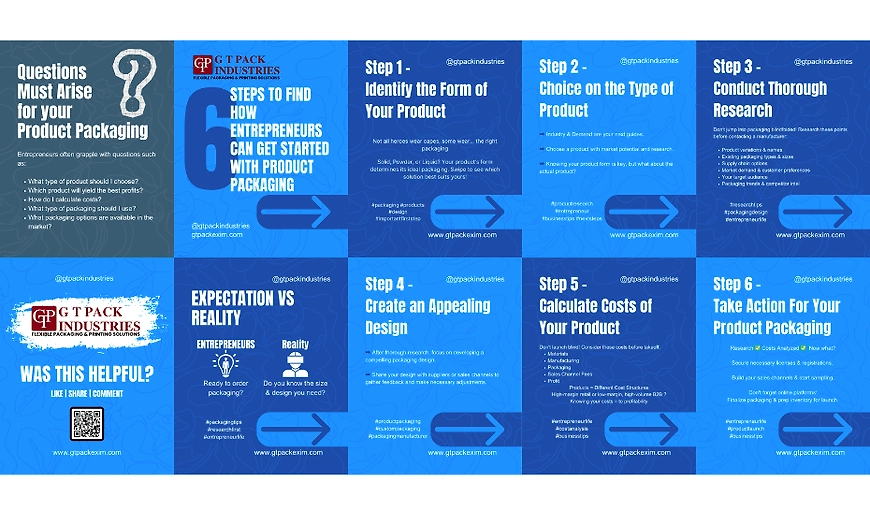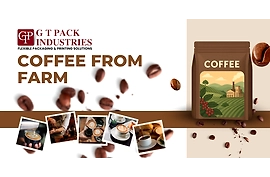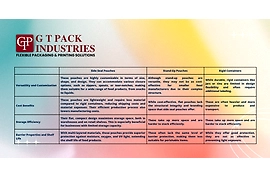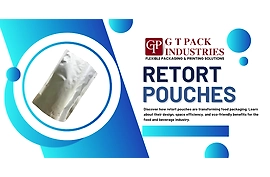6 Steps To find How Entrepreneurs Can Get Started with Product Packaging
| 12 Jul 2024
How Entrepreneurs Can Get Started with Product Packaging in 6 Steps
In today's dynamic market, entrepreneurship is thriving in India. With the country's shift towards self-employment and small business creation, many individuals are eager to launch their own product or service-based ventures.
it's surprising how often entrepreneurs neglect fundamental research about their products and market requirements. As a packaging manufacturer, I frequently receive calls from businesses seeking packaging materials, but they often lack basic information about the sizes and designs they need. It's essential for any business owner to understand their product's packaging needs by researching market trends and competitor offerings. Knowing what types, sizes, and styles of packaging are used in the industry is crucial before reaching out to a packaging manufacturer.
However, one common hurdle that aspiring entrepreneurs face is understanding the intricacies of product packaging. Questions often arise about packaging styles, design, weights, content grammages, specifications, and required sizes. As someone who frequently consults with individuals on these issues, I've noticed a recurring pattern of challenges.
Entrepreneurs often grapple with questions such as:
-
- What type of product should I choose?
- Which product will yield the best profits?
- How do I calculate costs?
- What type of packaging should I use?
- What packaging options are available in the market?
Many businesses mistakenly shift the responsibility of this research onto the packaging manufacturers, expecting them to define the specifications and designs. However, packaging manufacturers are not experts in every product and cannot determine the ideal packaging without clear guidance. It's imperative for business owners to do their homework, understand their packaging requirements, and provide specific details to the manufacturers. This preparation ensures efficient collaboration and successful packaging solutions, rather than relying on manufacturers to shoulder the entire burden of research and design
To navigate these challenges, here’s a structured approach to getting started with product packaging:
Step 1 - Identify the Form of Your Product
Products are from three categories usually: solid, powder, or liquid. Each form requires specific packaging solutions:
-
- Solid Products: Items like bearings, plastic bottles, or artifacts are usually packaged in boxes or monocartons.
- Powdered Products: Products such as protein powder, sugar sachets, or food items are best packaged in flexible packaging or laminated materials.
- Liquid Products: Items like oil, water, or liquid soap are typically packaged in multilayer pouches or plastic bottles.
Choosing the right form of packaging for your product is the first and Most important step.
Step 2 - Choice on the Type of Product
Once you've identified the product form, the next step is to choose a specific product to sell. This decision will guide you in determining the necessary licenses and compliance requirements. Consider the industry you want to enter and the product's market demand.
Step 3 - Conduct Thorough Research
Research is crucial in understanding your product and its market Investigate:
-
- Product names and variations available.
- Types of packaging used and available sizes.
- The number of manufacturers, traders, and sales channels for supply.
- Market demand and customer preferences.
- Customers your product will cater to.
- Packaging design trends and what competitors are offering.
Step 4 - Create an Appealing Design
After thorough research, focus on developing a compelling packaging design. Share your design with suppliers or sales channels to gather feedback and make necessary adjustments.
Through This exercise, you will get to know about your product and types of packaging you use for your product as per feedback.
This will help you to analyse various aspects such as.
-
- Crafting an eye-catching design: This is where your research on market trends and competitor offerings comes to life! Use your findings to create a design that pops on the shelf and reflects your brand identity.
- Gathered feedback & iterate helps in improvement of your design: Don't go it alone! Share your design with suppliers who understand packaging limitations and sales channels who know what resonates with customers. Their feedback will help you refine your design, ensuring it's not only attractive but also functional and well-received by your target audience.
- Focused research helps to polish the Packaging design: The text you provided suggests you might learn about your product through feedback on the design. However, the key is to leverage your research to inform the design initially. Feedback should help polish the design, not dictate the core concept.
Step 5 - Calculate Costs
Understanding your costs is essential for profitability. Consider the expenses for raw materials, job work, packaging, commissions to sales channels, and expected profits.
Different products will have varying cost structures.
Some might be high-margin retail items, while others could be low-margin, high-volume B2B products.
Step 6 - Take Action
With all the above steps completed, it’s time to put your plan into action. For instance, if you're entering the detergent powder market, you’ll need to secure chemical licenses, pollution certificates, and tax registrations. Establish your sales channels and start sampling to attract orders. Given the digital shift, registering on online selling platforms is crucial. Ensure you have inventory ready for immediate shipment once your packaging is finalized.
By following these steps, you can successfully launch your business and ensure that your product packaging meets market standards and customer expectations.
#businesstips #costanalysis #saleschannels #onlineselling #entrepreneur #entrepreneurlife #startupbusiness #smallbusiness #madeinindia #productdevelopment #productlaunch #productpackaging #packagingdesign #marketresearch







